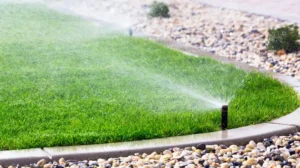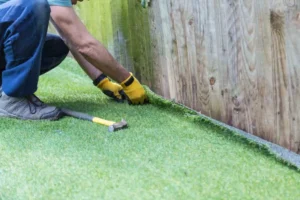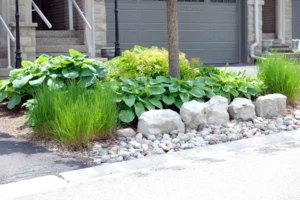When you install sod in your yard, one of the most common questions homeowners have is, “How long does sod take to root?” While the answer can vary depending on several factors, it’s necessary to understand the rooting process to ensure your sod establishes itself properly. In this article, we will explore the key elements that influence how long it takes for sod to root, how to care for it, and tips to speed up the rooting process for a healthy and vibrant lawn.
What Does Rooting Mean for Sod?
Rooting refers to the process where the sod’s roots penetrate into the soil beneath it, forming a connection between the grass and the earth. This crucial stage allows the grass to take in nutrients, water, and air, helping it grow strong and healthy. So, how long for sod to establish its roots? Typically, the rooting process can take anywhere from 2 to 3 weeks under ideal conditions.
How Long Does Sod Take to Grow?
After you lay the sod, it’s essential to understand that the grass won’t grow at the same pace as other plants or seeds. While sod comes pre-grown, it still requires time to settle in and start growing. On average, it can take up to 2 to 3 weeks for new sod to take root. However, several factors like climate, soil quality, and maintenance play a role in determining the exact time it will take for sod to grow and become established.
How Long for Sod to Take Root?
The time it takes for sod to take root depends on several factors, including soil temperature, moisture levels, and the type of grass you’re using. Generally speaking, how long until sod takes root can range from 2 weeks to 4 weeks. During this time, the roots are growing into the soil, forming the base for healthy lawn development. However, in hot weather, this process may be slower unless proper care is taken.
How Long Does It Take New Sod to Root?
New sod requires careful attention to ensure it roots properly. The initial rooting period can take up to 3 weeks, but if the weather is too hot or the soil isn’t ideal, it might take longer. The key is to provide the best way to water sod and ensure it receives adequate sunlight and nutrients during this period.
How to Help Sod Root
To help sod root effectively, you need to focus on providing the right conditions. Regular watering, proper soil preparation, and adequate sunlight all contribute to faster root development. In addition to watering, how to get sod to grow more efficiently includes making sure the soil is well-aerated and free from any debris that could hinder root penetration.
How to Water New Sod
Watering is a critical factor in helping your sod take root. The first step after installation is to water thoroughly, soaking the sod and the soil beneath it. How long to water sod after installation depends on the weather, but it’s typically recommended to water the sod twice a day for the first few weeks. In hot weather, you might need to increase watering frequency to prevent the sod from drying out.
How Long Should You Water New Sod?
Generally, you should water your new sod for about 15-20 minutes per session for the first few weeks. This ensures the water penetrates deep into the soil and encourages the roots to grow deeper. During the initial stages, ensure that the soil beneath the sod stays moist but not soggy.
Watering New Sod in Hot Weather
Watering new sod in hot weather requires extra attention. In high temperatures, sod can dry out quickly, so you may need to water more frequently. Consider watering your sod early in the morning or late in the evening to minimize evaporation and ensure the roots have enough moisture to develop.
What to Do After Sod is Laid
After sod installation, it’s essential to keep sod moist and make sure the grass receives the right nutrients. The sod after 1 week should show signs of root development, and you should start to see the grass growing as it becomes more established. It’s important to avoid walking on the sod during the first few weeks to prevent damaging the fragile roots.
Can You Walk on Sod Right Away?
It’s advisable not to walk on sod immediately after installation. Can you walk on sod right away? While it’s tempting to admire your new lawn, it’s best to avoid walking on it until the roots have had a chance to establish themselves. Walking on freshly laid sod can disrupt the roots and slow down the rooting process.
How Long Does Sod Take to Root in Hot Weather?
If the temperatures are high, rooting will take longer. How long does sod take to root in hot weather can extend to 4 weeks or more, depending on how well you manage watering and care. High heat and direct sunlight can stress the sod, making it harder for the roots to establish. During hot weather, ensure you water more frequently, especially in the early morning or late evening.
Signs That Sod Has Taken Root
As the sod roots into the soil, there are a few signs that sod has taken root. One of the first indicators is when you try to lift a piece of sod and feel resistance, showing the roots are attached to the soil. Additionally, healthy sod will begin to show signs of growth, and the grass will become greener and more vibrant.
How to Speed Up Sod Rooting
If you’re wondering how to speed up sod rooting, there are several tips that can help. First, ensure you are consistently watering the sod, but avoid over-watering. Additionally, make sure the sod gets adequate sunlight and doesn’t sit in overly shaded areas. You can also use a fertilizer designed for new sod to give it a boost.
Factors Affecting Sod Rooting Time
Several factors can influence how long for turf to root properly. These include:
-
Soil Type: Sandy or loamy soils allow roots to penetrate more easily, while clay-heavy soils may slow down rooting.
-
Temperature: Soil temperature plays a significant role in the rooting process. The ideal temperature for sod to root is between 50°F and 65°F (10°C to 18°C).
-
Watering: Proper watering is key, especially during the early stages.
-
Sod Type: Some grass varieties root faster than others, so the type of sod you install can affect how long it takes for the roots to establish.
Sod Root Growth Stages
Understanding root development in newly installed sod involves recognizing the key growth stages:
-
Initial Stage (1-2 weeks): Roots start to form and penetrate the soil. At this stage, water and light are crucial.
-
Establishment Stage (3-4 weeks): The sod’s roots begin to spread and anchor deeper into the soil.
-
Mature Stage (1-2 months): The roots are fully established, and the sod has integrated into the soil, making it more resilient to environmental stress.
How Long to Establish Sod
It generally takes about 4 to 6 weeks for sod to become fully established. During this period, it’s crucial to monitor the sod closely and adjust watering and care practices accordingly. With the right care, your sod will be rooted deeply enough to survive and thrive.
Conclusion
Understanding how long does sod take to root is key to ensuring a lush and healthy lawn. While it typically takes between 2 to 3 weeks for sod to begin rooting, several factors like temperature, watering, and soil quality can influence this timeline. By following the proper care guidelines and paying close attention to the needs of your new sod, you’ll enjoy a well-established lawn in no time.
Transform Your Lawn with Expert Landscaping & Turf Services
We offer premium turf installation and landscaping services to bring your vision to life!
Frequently Asked Questions (FAQs)
How long should I water new sod after installation?
Watering new sod should be done thoroughly twice a day for the first few weeks, depending on the weather conditions.
What can I do if my sod isn’t rooting?
If your sod isn’t rooting, check the soil moisture, ensure proper sunlight, and consider using a root stimulator fertilizer.
Can I walk on sod after one week?
It’s best to avoid walking on the sod until the roots are well-established, typically after 3 weeks or more.
What is the best way to water sod?
Water the sod early in the morning or late in the evening to reduce evaporation, ensuring deep water penetration.
How can I speed up sod rooting?
Regular watering, proper fertilization, and ensuring the sod receives adequate sunlight can help speed up the rooting process.
How do I know when my sod has taken root?
When the sod resists being lifted and shows signs of growth, it has likely taken root and is beginning to establish itself in the soil.






